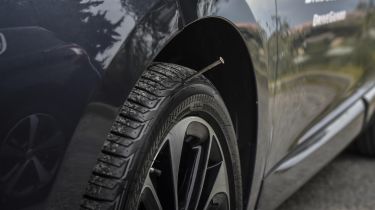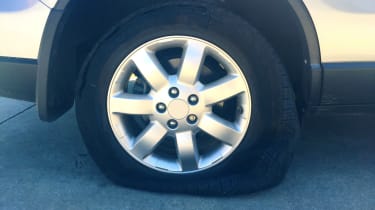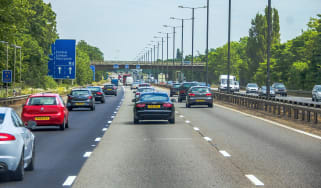How to spot a slow puncture and what to do if you have one
Ignoring a slow puncture can be dangerous and costly. We’ve put together our top tips to help you spot and fix one

There are few things more irritating than a punctured tyre. You’re driving along, minding your own business, when you notice a ticking noise from the front or a dashboard warning light illuminates. You pull over to check everything is in order and – there it is. A great big nail stuck in the tyre tread.
Can I keep driving?
Whilst you may be tempted to continue on your way, a punctured tyre can become hazardous while driving, so you should avoid driving the car until the tyre can be repaired or replaced. Slow punctures are particularly dangerous as you may not notice one at first, but it will likely get worse the further you drive, gradually reducing your car control and braking distance until the car is unsafe to drive. If you’ve encountered a slow puncture and you’re trying to establish the possible causes or how to fix the problem, there are a number of things you need to consider.
The tyres on your car are perhaps its most vital safety component; they might only have a small contact patch with the road but they affect your car’s braking, steering and general roadholding. Ensuring your car is equipped with good quality tyres that are in decent condition, especially in wet and wintry driving conditions, could well save someone’s life, so it’s vital to monitor their condition on a regular basis. This is especially true these days, as extended service intervals mean trips to the dealership for regular maintenance are few and far between.
While we’re all aware of the requirements to have tyres with a decent tread depth – the legal minimum is 1.6mm in a continuous band around the central three-quarters of a tyre – we tend to pay less attention to the possibility that one or more of the tyres on our cars might have a slow puncture.
How do I visibly spot a slow puncture?

If you’ve recently passed your driving test, you will no doubt be familiar with the guidance in the Highway Code that you should give your car a visual inspection each and every time you drive. However, it’s likely that many of us may have forgotten this advice, especially when ‘life gets in the way’ and you’re frequently jumping in and out of the car. Checking the tyres is one step that can take less than a minute, and only requires you to walk around your car once. When you do find time to check them, here are a few things to look out for:
- Deflated or bulging tyres – Make sure there aren’t any bulges that suggest one or more tyres are partially deflated, and there are no obvious tears or signs of damage on the sidewalls.Have the tyres changed shape or do they look flat – do any of them look to be sagging under the weight of the car?
- Wear to the sidewall – In extreme cases in which a tyre has been under-inflated for some time, you may also notice some wear to the sidewall. This is where the maker’s name and tyre numbering are printed and will have become worn away where it has come into contact with the road.
- Objects stuck in the treads – Even if the tyre doesn’t look flat, an object stuck in the tread could create a slow puncture that gets worse with time. You can examine the tyre tread for anything that shouldn’t be there; screws, nails or other debris that’s become lodged in the tyre tread. If you do spot something like this, it’s best to get the advice of a professional tyre fitter to check if it can be repaired or needs to be replaced.
- Damaged or faulty tyre valve – This is unusual but could still occur nonetheless. If the tyre valve stem is visibly damaged, or broken off entirely, it will impact the tyre’s ability to hold air and it should be replaced as soon as possible. Even if the valve dust cap has gone missing, dust and grit can get into the valve causing it to lose air
- Damage to the wheel rim – If a wheel is warped or cracked, it could create a slow leak of air, so it’s worth checking your tyre pressure if you notice any damage. Minor damage, such as scraping or kerb rash, isn’t something to be concerned about.
There’s a chance that, while the foreign object may have pierced the tread, it hasn’t actually made it all the way through so removing it immediately will prevent any further damage. Conversely, it might actually be plugging the hole and keeping the tyre inflated – removing it will cause the tyre to deflate more quickly. If you do remove a foreign body from the tyre, try putting a few drops of water onto the damaged area – this will allow you to spot air bubbles escaping from the tyre so you can take immediate action and have the tyre repaired or replaced.
When examining a tyre, it’s recommended that you wear gloves made of tough material to avoid catching your fingers on any metal wire that can be exposed by a puncture or severe wear. Tyres have two layers of wire under the tread to protect against bumps and heat. In some cases where a tyre has been worn beyond the legal limit, these wires may be exposed. Tyres in this condition need to be replaced immediately.
How to spot a slow puncture while driving
When you’re behind the wheel, turn off the radio and listen carefully for the telltale ticking noise that you will experience if there is a foreign body in the tyre tread – the noise will speed up and slow down with the pace of the car. You may also notice a difference in the way the car handles. Look out for these key signs:
- Pulling to one side or the other when holding the steering wheel lightly
- Pulling in one direction when using the brakes
- A noticeable change in roadholding – maybe it wallows when going over bumps?
- More road noise than usual, especially if you lower a window slightly
- An unusual vibration through the steering wheel, potentially caused by a deflated tyre
- Any car manufactured from November 2014 legally has to have a tyre pressure monitor system fitted, so most cars on the road will alert you via a dashboard warning light if a puncture is detected
If you experience any of these issues, then you should stop immediately, inspect your tyres and take your car to a tyre fitter for further inspection.
Checking tyre pressures
A mechanic will likely check your tyre pressures when you bring your car in for a service. However, most modern cars tend to have long service intervals, so see the inside of a workshop less frequently. To make sure your tyres are always inflated correctly, it’s worth investing in a hand-held tyre pressure gauge and either an electric or hand-held foot pump with a gauge attached. They don’t tend to be very expensive and spotting one slow puncture before it becomes an issue could well save far more money than the purchase price of the gauge or pump; decent tyres cost anywhere between £50 to £300 depending on the brand. Checking the tyre pressures on a weekly basis and before long journeys is good practice and should take no more than a few minutes.
Where to find tyre pressure values varies from car to car, but try checking the owner’s manual first. If they’re not in there, they’re likely printed on a sticker on the driver’s door sill or behind the fuel cap. Remember that there are often different values for front and rear tyres as well as for different vehicle loads. If you’re taking the family on holiday with a boot full of luggage, you may need to inflate your tyres to a higher pressure, so check the manufacturer’s recommended values.
Although you can check your tyre pressures at a petrol station, the gauges aren’t generally as accurate as the gauge that you keep at home or in the glovebox. The ones at the forecourt live a tough life and can be out of service when you need them, so it's better to have your own kit. Another reason to check tyre pressures at home is that you can do so while the tyres are still cold. When tyres heat up, the air inside them can expand, leading to an inaccurate pressure reading.
If you have a car that was registered after 1 November 2012, or one that was produced before that date but is fitted with run-flat tyres, then your car will be equipped with a tyre pressure monitoring system (TPMS). You will get a dashboard warning from the car if it detects a tyre is low on pressure, alerting you to pull over in a safe place and inspect the tyres for a puncture.
Can you fix a slow puncture?
Whether a slow puncture can be repaired or not will very much depend on what has caused the puncture and for how long it’s existed. The best course of action will be to take your car to a tyre specialist as soon as you become aware of the puncture. Driving on a punctured tyre for longer than is necessary could well be dangerous and may end up costing more money, as a tyre that’s been driven on in a semi-inflated state may not be repairable.
If debris or a foreign object piercing the tread is the cause of the slow puncture, then the chances are that the tyre can be repaired. However, if the damage is right at the edge of the tread by the sidewall, then it can’t be repaired.
This can become very expensive, as some vehicles fitted with all-wheel drive require a minimal difference in tread depth between tyres across an axle. If the new tyre and the existing tyre are outside of this tolerance, it may be necessary to fit new tyres to both wheels on that axle.
What about run-flat tyres?
Run-flat tyres are the exception to the rule regarding puncture repairs. These tyres are designed to be driven on for a distance while ‘flat’ – usually 50-100 miles depending on the manufacturer and the load in the vehicle – by using much stiffer sidewalls than normal tyres. This makes it almost impossible for a tyre dealer to know whether or not the structure of the tyre has been affected, so the majority of the major national chains will refuse to repair them.
If the tyre has sidewall damage, either from hitting a pothole, kerb, or from having some debris from the road lodged in it, then you will also need a new tyre as its structure will have been affected.
As mentioned earlier, it’s also possible that a slow puncture could be the result of a damaged wheel rim. On older cars with steel rims, it’s possible that rust has built up on the wheel rim, which can lead to the tyre having a poor seal where it joins the wheel rim. Similarly, a wheel rim that has been damaged by a kerb or pothole could cause a slow puncture. In the case of split rims fitted to some high-performance cars, there could be a leak where the parts of the wheel join together. In this situation, you should have the wheel sent to a specialist for repair or source a new one.
In extreme cases, it is also possible for the metal of the wheel to become porous over time, but this is very unusual and is most likely to occur with specialist magnesium wheels.
You might also be tempted to use a can of tyre sealant to cure a slow puncture but this isn’t recommended. Tyre sealant is generally a product used to temporarily repair a puncture when on the road or motorway, and isn’t recommended for permanent repairs. It’s also worth noting that once this type of sealant has been used it may make the tyre unrepairable so should really only be used in an emergency.
The best practice is to inspect the condition and pressure of your car’s tyres on a regular basis – once a week if possible. Ignoring a slow puncture can be dangerous as a partially inflated tyre will cause an imbalance in your car’s road-holding and braking performance, and could lead to a blowout where the tyre's structure completely fails. Driving on a tyre with a slow puncture can easily damage the tyre, meaning you will have to pay for a replacement rather than a repair.
For more information on maintaining your tyres, check out our guide to tyre tread depths…
Recommended

Classic car tax exemption: which historic vehicles qualify?
Most Popular
Tips & advice

Car dashboard warning lights: what does each symbol mean?

Electric car charging stations: public networks, charger types, apps and maps








